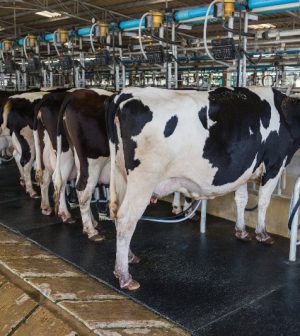- Gas Stoves Could Leave Your Lungs Vulnerable to Nitrogen Dioxide
- Key Therapy Equally Effective for Women, Men With Narrowed Leg Arteries
- Doctors Describe Texas Dairy Farm Worker’s Case of Bird Flu
- Does Preschool Boost Kids’ Long-Term Academic Success? Study Finds Mixed Results
- AI Might Spot Rare Diseases in Patients Years Earlier
- An Orangutan Healed Himself With Medicinal Plant
- Quit-Smoking Meds Not Working for You? Try Upping the Dose
- Fewer Americans Are Suffering Most Dangerous Form of Heart Attack
- Even Skipping Meat for One Meal Helps Liver Disease Patients
- You May Not Have to Fast Before Catheter-Based Heart Test, Study Suggests
Fragments of Bird Flu Virus Found in U.S. Milk Supply

Bits of inactive bird flu virus have been discovered in samples of pasteurized milk from across the United States, health officials said Tuesday, although they stressed the viral fragments don’t threaten humans.
However, the U.S. Food and Drug Administration did note that testing suggests that bird flu has likely infected far more dairy cows than officials realized.
Still, “to date, we have seen nothing that would change our assessment that the commercial milk supply is safe,” the agency stressed in a statement updating the investigation.
Over the last month, a bird flu virus known as H5N1 has been detected in dairy herds in nine states. The virus is also known to have infected one farmworker, whose sole symptom was pink eye.
The viral fragments pose little risk to consumers who drink milk, David O’Connor, a virologist at the University of Wisconsin-Madison, told the New York Times.
“The risk of getting infected from milk that has viral fragments in it should be nil,” he explained. “The genetic material can’t replicate on its own.”
FDA officials didn’t elaborate on how many milk samples had tested positive or exactly where the samples came from, the Times reported.
If the fragments surfaced in samples throughout the commercial milk supply, it would suggest far more cows have been infected than believed, experts said.
“The problem in dairy cows might be much bigger than we know,” O’Connor said. “That would be the concern — not that the milk itself would be a risk.”
FDA officials noted they are waiting on results from experiments that will determine whether the milk samples contain active virus.
Most of the milk produced on U.S. farms is pasteurized, a process that typically kills germs with heat. Pasteurization should also inactivate flu viruses, which are known to be fragile and heat-sensitive, experts added.
Still, the FDA has only recently begun testing pasteurization’s effectiveness on H5N1, so the risks aren’t fully known yet, the Times reported.
Brian Ronholm, director of food policy at Consumer Reports, told the Times it would be “very critical” for health officials to clearly communicate the final findings and educate consumers about what they mean.
But experts still urged folks to stay calm.
“With a virus like this, I would have to believe even if you had the highest levels of virus activity you could ever imagine in the actual milk from the udder of an infected cow, it would be diluted millions of times over going into pasteurization,” Michael Osterholm, an infectious disease expert at the University of Minnesota, told the Times.
Ingested milk is also broken down by the body’s digestive and immune systems, so “I wouldn’t worry about [viral] remnants,” Dr. Nahid Bhadelia, director of the Boston University Center on Emerging Infectious Diseases, told the Times. “As long it’s not a live virus, it is unlikely that there’s any health risks.”
More information
The U.S. Centers for Disease Control and Prevention has more on the bird flu.
SOURCES: U.S. Food and Drug Administration, news release, April 23, 2024; New York Times
Source: HealthDay
Copyright © 2024 HealthDay. All rights reserved.










